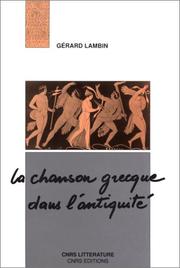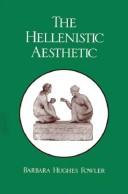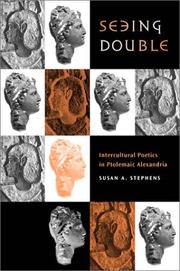| Listing 1 - 10 of 17 | << page >> |
Sort by
|
Book

ISBN: 8883380274 Year: 2006 Publisher: S.l. Fridericiana
Abstract | Keywords | Export | Availability | Bookmark
 Loading...
Loading...Choose an application
- Reference Manager
- EndNote
- RefWorks (Direct export to RefWorks)

ISBN: 2222047110 9782222047117 Year: 1992 Publisher: Paris: CNRS éditions,
Abstract | Keywords | Export | Availability | Bookmark
 Loading...
Loading...Choose an application
- Reference Manager
- EndNote
- RefWorks (Direct export to RefWorks)
Lyric poetry --- Greek poetry --- History and criticism --- -Lyric poetry --- -Poetry --- Greek literature --- History and criticism. --- -History and criticism --- 78.22 --- Lyric poetry - History and criticism --- Greek poetry - History and criticism
Book
ISBN: 8882680207 Year: 2008 Publisher: Messina, : Dipartimento di scienze dell'antichità dell'Università degli studi di Messina,
Abstract | Keywords | Export | Availability | Bookmark
 Loading...
Loading...Choose an application
- Reference Manager
- EndNote
- RefWorks (Direct export to RefWorks)
Greek poetry --- Manuscripts, Greek (Papyri) --- Greek papyri --- Papyri, Greek --- Manuscripts, Classical (Papyri) --- Manuscripts (Papyri) --- Greek literature --- Manuscripts --- Goodspeed, Edgar J. --- Goodspeed, Edgar Johnson,

ISBN: 0299120449 0299120406 1853991090 Year: 1989 Publisher: Madison, Wis. University of Wisconsin Press
Abstract | Keywords | Export | Availability | Bookmark
 Loading...
Loading...Choose an application
- Reference Manager
- EndNote
- RefWorks (Direct export to RefWorks)
Aesthetics of art --- Antiquity --- Greece --- Aesthetics, Ancient. --- Art and literature --- Art, Hellenistic. --- Greek poetry, Hellenistic --- Hellenism. --- History and criticism. --- Aesthetics, Ancient --- -Art, Hellenistic --- -Hellenism --- History and criticism --- Hellenistic Greek poetry --- Greek literature, Hellenistic --- Hellenistic art --- Art, Greek --- Literature and art --- Literature and painting --- Literature and sculpture --- Painting and literature --- Sculpture and literature --- Aesthetics --- Literature --- Art, Hellenistic --- Hellenism
Book
ISBN: 2724702379 2724702387 2724702395 9782724702378 9782724702385 9782724702392 Year: 1999 Volume: 115 Publisher: Le Caire : Institut francais d'archeologie orientale,
Abstract | Keywords | Export | Availability | Bookmark
 Loading...
Loading...Choose an application
- Reference Manager
- EndNote
- RefWorks (Direct export to RefWorks)
Dioscore d'Aphrodité est un cas unique en papyrologie : le dossier de ce notable lettré d'un village de Moyenne-Égypte (VIe s. apr. J.-C.) comprend à la fois ses archives documentaires, sa bibliothèque et les brouillons de ses œuvres poétiques. Ce livre propose une édition critique et commentée de la partie littéraire de ce riche ensemble. Tout d'abord, des textes nouveaux ou partiellement inédits provenant de sa bibliothèque : une Iliade d'Homère, un livre de Scholies à l'Iliade et des tables de conjugaisons verbales. Dans une seconde partie, l'œuvre même de Dioscore : 51 textes autographes, presque tous en vers, traduits, annotés et replacés dans leur contexte littéraire et historique. Un chapitre conclusif tente de brosser le profil culturel de Dioscore en s'appuyant sur sa bibliothèque, sur son œuvre, mais aussi sur ses textes documentaires. La combinaison de ces trois sources permet de faire revivre conjointement l'élève, le lecteur et le créateur, autant de phases que le papyrologue ou l'historien de la littérature est habituellement obligé d'appréhender séparément. Elle met aussi au jour d'intéressantes interactions entre littérature et documents, révélatrices des options culturelles de la société antique tardive. C'est donc, plus généralement, de la culture grecque dans une province du VIe s. que traite cet ouvrage.
Greeks --- Manuscripts, Greek (Papyri) --- Hellenism --- Grecs --- Papyrus grecs --- Hellénisme --- History --- Sources --- Histoire --- Dioscorus, --- Egypt --- Egypte --- Antiquities. --- Antiquités --- Greek poetry, Hellenistic --- Translations into French. --- Criticism and interpretation. --- Library --- Aphrodito (Extinct city) --- Hellenistic Greek poetry --- Greek papyri --- Papyri, Greek --- Translations into French --- Aphrodito, Dioscorus of --- Dioscore, --- Dioscoro, --- Διόσκορος, --- Dioskoros, --- Aphroditopolis (Ancient city) --- Aphroditopolis (Sūhāj, Egypt : Extinct city) --- E-books --- Hellénisme --- Antiquités --- Greek literature, Hellenistic --- Manuscripts, Classical (Papyri) --- Manuscripts (Papyri) --- Antiquities
Book
ISBN: 2845161751 9782845161757 Year: 2001 Volume: 2 Publisher: Clermont-Ferrand: Presses universitaires Blaise Pascal,
Abstract | Keywords | Export | Availability | Bookmark
 Loading...
Loading...Choose an application
- Reference Manager
- EndNote
- RefWorks (Direct export to RefWorks)
Music, Greek and Roman --- Music --- Church music --- Greek poetry --- Classical literature --- Musique grecque et romaine --- Musique --- Musique d'église --- Poésie grecque --- Littérature ancienne --- Congresses. --- Philosophy and aesthetics --- Congrès --- Philosophie et esthétique --- Musique d'église --- Poésie grecque --- Littérature ancienne --- Congrès --- Philosophie et esthétique --- 78.22 --- 78.16 --- Music, Greek and Roman - Congresses. --- Music - Philosophy and aesthetics - Congresses. --- Church music - To 500 - Congresses. --- Greek poetry - Congresses. --- Classical literature - Congresses.
Book
ISBN: 8855528793 9788855528795 Year: 2005 Volume: 12 Publisher: Bologna: Pàtron,
Abstract | Keywords | Export | Availability | Bookmark
 Loading...
Loading...Choose an application
- Reference Manager
- EndNote
- RefWorks (Direct export to RefWorks)
Manuscripts, Greek (Papyri) --- Inscriptions, Greek --- Greek literature, Hellenistic --- Papyrus grecs --- Inscriptions grecques --- Littérature grecque hellénistique --- Translations into Italian --- Traductions italiennes --- Erotic poetry, Greek --- British Library --- Littérature grecque hellénistique --- Greek papyri --- Papyri, Greek --- Manuscripts, Classical (Papyri) --- Manuscripts (Papyri) --- Greek erotic poetry --- Greek poetry --- British Library.

ISBN: 0520229738 9780520927384 0520927389 0585466491 9780585466491 1597348899 9781597348898 9786612356674 6612356677 9780520229730 1282356674 9781282356672 Year: 2003 Volume: 37 Publisher: Berkeley University of California Press
Abstract | Keywords | Export | Availability | Bookmark
 Loading...
Loading...Choose an application
- Reference Manager
- EndNote
- RefWorks (Direct export to RefWorks)
When, in the third century B.C.E., the Ptolemies became rulers in Egypt, they found themselves not only kings of a Greek population but also pharaohs for the Egyptian people. Offering a new and expanded understanding of Alexandrian poetry, Susan Stephens argues that poets such as Callimachus, Theocritus, and Apollonius proved instrumental in bridging the distance between the two distinct and at times diametrically opposed cultures under Ptolemaic rule. Her work successfully positions Alexandrian poetry as part of the dynamic in which Greek and Egyptian worlds were bound to interact socially, politically, and imaginatively.The Alexandrian poets were image-makers for the Ptolemaic court, Seeing Double suggests; their poems were political in the broadest sense, serving neither to support nor to subvert the status quo, but to open up a space in which social and political values could be imaginatively re-created, examined, and critiqued. Seeing Double depicts Alexandrian poetry in its proper context-within the writing of foundation stories and within the imaginative redefinition of Egypt as "Two Lands"-no longer the lands of Upper and Lower Egypt, but of a shared Greek and Egyptian culture.
Comparative literature --- Egyptian poetry --- Greek poetry, Hellenistic --- Language and culture --- Poetics --- Egyptian and Greek. --- Greek and Egyptian. --- History and criticism. --- History --- -Greek poetry, Hellenistic --- -Language and culture --- -Literature, Comparative --- -Poetics --- -Poetry --- Literature, Comparative --- Philology --- Culture and language --- Culture --- Hellenistic Greek poetry --- Greek literature, Hellenistic --- Egyptian literature --- History and criticism --- Egyptian and Greek --- Greek and Egyptian --- -Technique --- Ptolemaic dynasty --- Alexandria (Egypt) --- -Intellectual life --- Poésie grecque hellénistique --- -Poésie égyptienne --- Littérature comparée --- Langage et culture --- Histoire et critique --- Grecque et égyptienne --- Egyptienne et grecque --- Ptolemaic dynasty, --- Alexandrie (Egypte) --- Intellectual life. --- Vie intellectuelle --- Iskandarīyah (Egypt) --- Alexandrie (Egypt) --- Aleksandriyah (Egypt) --- Alessandria (Egypt) --- Alexandreia (Egypt) --- Aleksandria (Egypt) --- Alexantreia (Egypt) --- Alesandriʼa (Egypt) --- الإسكندرية (Egypt) --- الإسكندرية (مصر) --- اسكندرية (Egypt) --- Poetry --- Technique --- Ptolemies, --- alexandrian court. --- alexandrian poetry. --- alexandrian poets. --- ancient egypt. --- ancient greece. --- apollonius. --- argonautica. --- callimachus. --- egypt. --- egyptian culture. --- egyptian history. --- egyptian people. --- egyptian poetry. --- greek poetry. --- helen. --- hellenism. --- heracles. --- hiero of syracuse. --- hymns. --- literary criticism. --- literary theory. --- mythology. --- nonfiction. --- pharoah. --- poetics. --- poetry. --- political values. --- ptolemaic court. --- ptolemies. --- ptolemy philadelphus. --- regencies. --- royalty. --- rulers. --- theocritus. --- theogonies.
Book
ISBN: 9781107118256 1107118255 9781316339398 9781107543393 1107543398 1316455734 1316455254 1316457656 1316456218 131645861X 1316339394 1316452379 9781316458617 9781316457658 Year: 2016 Publisher: New York, NY
Abstract | Keywords | Export | Availability | Bookmark
 Loading...
Loading...Choose an application
- Reference Manager
- EndNote
- RefWorks (Direct export to RefWorks)
This book explores the persona of the artist in Archaic and Classical Greek art and literature. Guy Hedreen argues that artistic subjectivity, first expressed in Athenian vase-painting of the sixth century BCE and intensively explored by Euphronios, developed alongside a self-consciously constructed persona of the poet. He explains how poets like Archilochos and Hipponax identified with the wily Homeric character of Odysseus as a prototype of the successful narrator, and how the lame yet resourceful artist-god Hephaistos is emulated by Archaic vase-painters such as Kleitias. In lyric poetry and pictorial art, Hedreen traces a widespread conception of the artist or poet as socially marginal, sometimes physically imperfect, but rhetorically clever, technically peerless, and a master of fiction. Bringing together in a sustained analysis the roots of subjectivity across media, this book offers a new way of studying the relationship between poetry and art in ancient Greece.
Vase-painting, Greek --- Greek poetry --- Art and literature --- Subjectivity in art. --- Subjectivity in literature. --- Arts, Greek --- Peinture de vases grecque --- Poésie grecque --- Art et littérature --- Subjectivité dans l'art --- Subjectivité dans la littérature --- Arts grecs --- Themes, motives. --- History and criticism. --- History --- Thèmes, motifs --- Histoire et critique --- Histoire --- Greece --- Grèce --- Intellectual life --- Vie intellectuelle --- Art and literature. --- Arts, Greek. --- Greek poetry. --- Intellectual life. --- Vase-painting, Greek. --- History. --- To 1500 --- Greece. --- To 1500. --- Poésie grecque --- Art et littérature --- Subjectivité dans l'art --- Subjectivité dans la littérature --- Thèmes, motifs --- Grèce --- Greek literature --- Literature and art --- Literature and painting --- Literature and sculpture --- Painting and literature --- Sculpture and literature --- Aesthetics --- Literature --- Greek vase-painting --- Greek arts
Book
ISBN: 8822255674 Year: 2006 Volume: 13 Publisher: Firenze L. S. Olschki
Abstract | Keywords | Export | Availability | Bookmark
 Loading...
Loading...Choose an application
- Reference Manager
- EndNote
- RefWorks (Direct export to RefWorks)
Date le texte d'environ 400 av. J.-C. p. 10. Reproduction photographique intégrale agrandie (x 1,23) du papyrus, planches 1 à 30. - Texte en grec ancien (dialecte ionien atticisé) suivi de la traduction et d'un commentaire en anglais
Orpheus (Greek mythology) --- Greek poetry --- Inscriptions, Greek --- Orphée (Mythologie grecque) --- Poésie grecque --- Inscriptions grecques --- Translations into English --- Traductions anglaises --- 292.9 --- Religion Classical Greek and Roman Sects and reform movements --- Dionysia. --- Greece --- Religion. --- Orphée (Mythologie grecque) --- Poésie grecque --- Orpheus --- Religion grecque --- Cosmologie grecque --- Musée archéologique (Thessalonique, Grèce) --- Théogonie --- Ionien (dialecte) --- Orphisme --- Papyrus grecs --- Sources --- Manuscrits. Papyrus de Derveni --- 5e siècle av. J.-C. --- Manuscrits grecs --- Grèce --- Derveni (Grèce)
| Listing 1 - 10 of 17 | << page >> |
Sort by
|

 Search
Search Feedback
Feedback About UniCat
About UniCat  Help
Help News
News